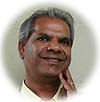|

Home
Artist
Articles
Paintings
Sculptures
Commissions
Contact
us |
  
Articles
about Prakash
Chandras

It was a moment frozen in time.
Nirshan Perera meets the artist who painted New York's skyline only hours before it changed.
India Abroad, November 30, 2001
Prakash Chandras is putting the finishing touches on Lower Manhattan, an oil painting that celebrates the unbroken skyline of New York. On the wall of his studio in the sleepy suburbs of San Jose, the Twin Towers still stand, pristine and heroic.
Other visions of urban America crowd the room: Under the artist's steady hand, cityscapes of San Francisco, Seattle, Houston, and Hawaii are in full bloom. Composed almost entirely of parallel lines, an original style that Chandras calls 'linearism' the canvases are all bold buildings, strong streets and limitless sky.
His My America series is a tribute to everything this country has done for him, says the 50 -year-old painter, sculptor and art professor.
"I grew to be who I am because of America." Chandras remarks. "I knew I could study art here and nobody could question me. It was the opportunity as well as the freedom that this country offers."
Growing up in his hometown of Bhor, a small village on the outskirts of Pune, Maharashtra, Chandras never thought he could realistically become an artist. Then a friendship he struck with two Peace Corps volunteers planted the seeds of his American Dream.
"They told me I could come to America," he recalls. "That anything was possible. They were wonderful."
In 1970, the volunteers arranged for his sponsorship and even loaned him the money for a plane ticket. But even after his arrival in the land of opportunity, young Chandras was the ever-dutiful Indian son.
Following his father's wishes, he enrolled in a business program at Eureka College in Illinois, and then obtained an MBA from the University of New Mexico. Afterward he returned to India, presented his degree to his father, and said: "Now I'm going to be an artist. If it doesn't work out, I can always go back to business and be unhappy in my life so you can be happy in yours."
In 1977, Chandras moved to New York framing pictures and rented a studio apartment on the East Side for $155 a month. One of the cityscapes in his My America series, From 10th Street, captures the view from the roof of that first apartment building.
"I lived poorly but was very happy," a smiling Chandras remembers. "Every Saturday I would get on the subway with my paints, go to different places - Brooklyn, Hoboken, Staten Island, - and paint what I saw. On Sundays, I would go to free lectures and seminars at museums and get this great art education.
"New York is the place to be if you're an artist," he continues. "There are incredible things you can learn just by being there. I think those years were better training than I could have gotten in any art school."
The four years he spent in New York helped crystallize his concept of linearism, which first came to him in a dream in 1975, says the painter.
"Since then, I've been painting everything in that style," he says. "The New York cityscape is so linear to begin with so it was easy to paint like that."
Chandras who moved to San Jose with his wife Karen in 1981, believes his novel technique reduces an image to its naked essence, breaking it down to what it truly is.
"I teach art history so I know very well that people have used parallel lines before," he notes. "But never have they depicted the whole painting.
"Linearism simplifies the image. I tell my students: Painting is easy, all you have to do is make a bunch of lines."
At the same time, the painter maintains, the style is incredibly challenging and demands mature craft and skill. "It looks simple, but to do it effectively, with texture and color, you must work with a lot of complicated elements of painting," Chandras observes.
Edward Seichie, a San Jose artist and gallery owner, says of the method: "I think the style and feel of linearism is profound. It really captures the harmony and the flow of the world in a way no other technique does. It's a very soothing and tranquil feeling you pull from it."
Several My America paintings are currently on view at Seichei's Art Made To Match gallery in Willow Glen. Chandras, who teaches at DeAnza College in Cupertino and Evergreen College in San Jose, has also had his work displayed at the Triton Museum and the San Jose Museum of Art.
To date he has completed 30 skylines of six American cities, including San Jose, and plans to do dozens more. His brush has even ventured abroad on occasion, taking on the horizons of Indian cities like Agra and Pune.
Chandras' cardinal rule in doing his cityscapes is that he must have a personal connection to every place he depicts. He never paints from magazines photographs or conjures cities in which he has never set foot.
"They have to spring from my own life experiences," he says, reflecting on his series. "I have been to all of these places, interacted with them in a meaningful way, and have many warm memories which flood my mind when I look at them.
"That's why I call it My America," he adds. "These paintings are really my way of possessing these places. I feel like I have all of them within me."
This chord wells up with particular urgency these days whenever Chandras gazes at his New York paintings that feature the unforgettable World Trade Center.
He actually completed one work, Central Park, on the night of September 10, hours before the buildings fell. On September 11, as the horror of the destruction played over and over again on television, Chandras gazed at the gleaming white rectangles he had painted the night before in disbelief. As the reality of what had happened sunk in, he signed his name in the lower left corner of the canvas with a cold and clammy hand.
"It was a moment frozen in time," the painter recalls. "I'll never forget that. It was like someone near and dear had passed away."
|
|
|
|
|
|
|
|


